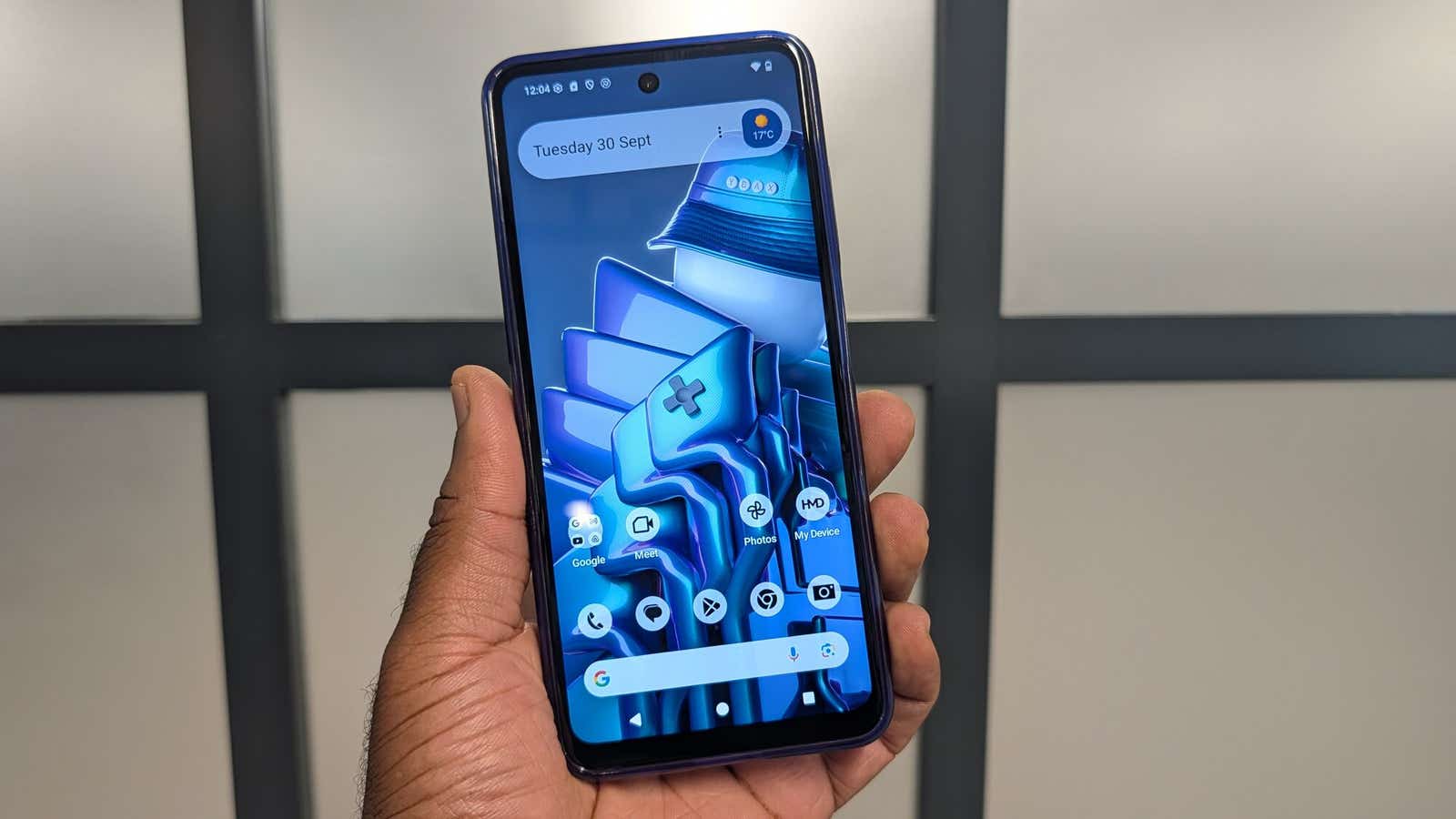HMD Fuse Review


HMD Fuse pros and cons
Super-secure AI safety tools.
Companion app gives parents genuine oversight.
3.5mm headphone jack is welcome.
Modest performance ceiling.
HarmBlock+ can feel intrusive to recipients during daily use.
Software update / support roadmap not fully defined.
HMD, the Finnish brand continuing Nokia’s legacy, has chosen a clear and deliberate path with their latest device - the Fuse.
It prioritises a safe, first smartphone experience for children, with trust and gradual independence over time as guiding principles.
HarmBlock+, HMD’s AI-powered protection system, runs at the Fuse’s system level and scans content across apps, live streams, and even the camera to prevent both viewing and creation of adult content.
Alongside this, a companion app gives carers powerful tools to guide and manage how the device is used.
Read our HMD Fuse review to see if this device succeeds as a very modern solution to a very modern problem.

Design and specifications
First and foremost, the HMD Fuse looks and feels every bit a proper Android smartphone - meaning it'll meet the high bar kids have for their tech.
Its 6.56-inch LCD screen is framed by modest bezels, housed in a body that measures 164.1 x 75.5 x 8.3mm and weighs just over 200g.
Given that it goes toe-to-toe with a Pixel 10 Pro XL in terms of dimensions, it might veer into being a touch large for the intended audience!
A plastic rear and frame does keep the weight sensible, improves grip, and adds resilience, which suits younger hands and daily knocks, whilst an IP54 rating gives some confidence against spills or sudden showers on the walk to school.
A pair of stylised and colourful cases are packed in with the device, but given all the exposed screws, angular panels and minimalist design, there’s something to be said for how the Fuse looks as standard.

Internally, the Snapdragon 4 Gen 2 chipset drives the experience. Paired with 6GB of RAM and 128GB of storage, it delivers a balance between performance and efficiency. Expansion via microSD - up to 1TB - is particularly welcome in a world where most smartphones have abandoned this feature. For children storing schoolwork, music, or photos, that flexibility will prove useful.
The battery is another strong point. At 5,000mAh, with 33W wired charging, the Fuse can comfortably last into a second day of use. USB-C ensures compatibility with modern chargers, but the inclusion of a 3.5mm headphone jack alongside Bluetooth feels just as important.
Children can use affordable wired headphones without fuss, and parents don’t need to worry about them losing expensive wireless buds.
Connectivity is robust too, with 5G, Wi-Fi, Bluetooth, and eSIM support all included. On paper, the Fuse is every inch a capable modern smartphone - it just happens to pack unique safety credentials to boot.
Display and audio
The Fuse’s display is a genuine highlight. Its 6.56-inch HD+ panel might not carry the pixel density of a Full HD screen, yet the 90Hz refresh rate lifts the overall experience. Menus scroll with ease, animations feel fluid, and casual games benefit from the added smoothness.
Colours lean towards natural rather than exaggerated, which keeps the panel comfortable for longer sessions of browsing or video.
Peak brightness of around 600 nits ensures good visibility indoors and remains usable outdoors, though direct sunlight will challenge it. For schoolwork, video calls, and streaming, the screen feels more than capable, with only fine text occasionally exposing the resolution’s limits.
Audio performance is modest but carefully thought through. A single loudspeaker delivers clear output for calls and short clips, and HMD has bolstered this with OZO Audio processing, which adds an extra layer of clarity when recording sound or capturing video.
The inclusion of a 3.5mm headphone jack is another practical touch, giving children an easy way to plug in wired earphones during commutes or in classrooms.
For those preferring wireless options, Bluetooth connectivity supports Qualcomm aptX, ensuring better audio quality with compatible headphones. Together, these levels of support give the Fuse a flexible and friendly approach to audio.

Performance, software and Harmblock+
Day-to-day use on the Fuse feels smooth. The Snapdragon 4 Gen 2 chipset may not be designed for hardcore gaming, but it is more than capable of handling messaging, browsing, video calls, and productivity apps alike.
For children moving between homework, chat apps and casual entertainment, it provides enough performance without generating unnecessary heat or drain.
HarmBlock+ is where the Fuse truly distinguishes itself. This AI-driven layer goes deeper than a typical Android app, functioning as a built-in system feature that cannot be bypassed and is configured upon booting the device.
It screens every image, video, and live stream in real time, stepping in to block or obscure anything deemed inappropriate. If a child tries to take a prohibited photo, the frame is wiped. If a live stream begins to cross the line, it is cut off instantly.
The companion Harmblock+ app is equally important. From here, caregivers can approve or deny app installations, manage contacts, and set those all-important time limits. Geographical safe zones can also be defined, so if the Fuse leaves a set area - for example, the walk home from school - an alert is triggered.
This creates a practical layer of reassurance without requiring those constant check-ins - where even calls can be routed via the app. Point to note - the device does need a live SIM card with data in order to marry it to the guardian app for full set-up.
The Fuse begins life as a very restricted device, with only the most essential apps and contacts are accessible.
Over time, as children demonstrate responsibility, more freedom can be unlocked. This gradual progression mirrors the way independence develops in everyday life, giving parents a framework for teaching responsibility rather than simply enforcing it.
Of course, HarmBlock+ is not subtle. Apps may refuse to open without explanation, or content may vanish mid-use. This can frustrate children, who may feel unfairly restricted - although during testing with my eight-year-old daughter, who is entirely well versed in the strict time limits imposed on tablet time, experiencing the same here was met with a vocal - but familiar - response…

For parents, though, the clarity is invaluable. There is no ambiguity about what the phone will and will not allow, and no risk of settings being bypassed by web-savvy children.
This degree of oversight also makes the Fuse more resilient than typical smartphones that rely on third-party parental control software.
Those apps often need constant updates, can be disabled by deft little fingers, or fail to cover every corner of the device. With HarmBlock+, the Fuse is a closed environment where safety is clearly paramount.

These security features may sound familiar to those with children navigating their way around tablets or smartphones in the form of Google’s Family Link, where many similar settings can be managed.
It’s immediately clear that the degree of granularity, as well as the amount of oversight in terms of what your child is actually doing on the device - as well as where they are - is leagues beyond, not to mention its root-level ability to filter and prevent unsavoury content, lending peace of mind that we rarely have with stock safety settings.
One lingering concern is software longevity. HMD has yet to commit to extended OS upgrades or long-term security support. For a phone designed to evolve alongside a child, this uncertainty is worth noting.
Camera capabilities
At first glance, the camera setup seems almost overpowered for a safety-first phone. The 108MP main sensor and 50MP front camera suggest ambitions beyond the basics. In bright conditions, the rear camera produces clear, colourful shots with good detail. Landscapes and outdoor scenes look sharp, and casual snaps for messaging or school projects are more than satisfactory.
The selfie camera performs well too, producing flattering images and handling video calls with ease. For a device targeted at children and teenagers, this feels like an acknowledgement of the importance of video communication in modern life.
Low-light photography is less convincing. Noise creeps into darker scenes, and detail softens noticeably. The camera app does its best to balance highlights and shadows, but it cannot rival higher-end smartphones.

Video recording reaches up to 4K, with stability that holds up for walking clips, though rapid motion introduces jitter. Audio capture during video is strengthened by HMD’s OZO technology, which improves clarity and spatial balance when filming.
Paired with aptX support for playback over Bluetooth, recordings sound crisp whether reviewed on headphones or shared in calls.
Where the cameras stand out is in how they integrate with HarmBlock+. Content is screened in real time, meaning inappropriate images or streams are immediately intercepted.
While this may occasionally disrupt normal use, the presence of AI moderation directly in the camera pipeline sets the Fuse apart from any mainstream alternative.
Check out the latest mobile deals on Uswitch
Battery life and charging
Battery life is consistently strong. With limited apps and reduced background drain, the Fuse regularly stretches into a second day of use, meaning less pressure on children to remember nightly charging routines.
When power does run low, 33W wired charging via USB-C brings the phone back quickly. A short session before school is often enough for a full day’s use. For families with busy schedules, that practicality matters.

HMD Fuse UK pricing and availability
In the UK, the Fuse is currently available through Vodafone and Three. On Vodafone, pricing starts from £33 per month, with a small upfront cost (£30) on a bundled plan that includes 5GB of 5G data.
Three also offers similar packages, targeting families who want the safety features tied to a contract.
For those who prefer to buy outright, the Fuse is listed at £498 SIM-free This option may appeal to parents who want flexibility in choosing their own plan, or who intend to pair the device with a child-friendly SIM deal.
Pricing reflects the dual identity of the Fuse - part smartphone, part service, both working together as a package.

Final verdict
The HMD Fuse stands apart in today’s smartphone landscape. By embedding AI safety controls at the core of the device, it addresses concerns that ordinary parental control apps cannot.
For parents, this translates into clarity and reassurance. For children, it provides a device that feels genuine and modern, without being a watered-down embarrassment in the playground.
There are trade-offs in what is admittedly a relatively niche device. Performance is modest - albeit close to parity for this price point, the experience can feel overly restrictive at times for budding smartphone owners given the AI-assistance isn’t quite an exact science in what it deems off limits, and the lack of guaranteed long-term updates is a concern.
Yet there’s something to be said for offering parents the choice of a safe, structured first smartphone - and in that, the Fuse succeeds with conviction.
For families who prioritise trust, clarity, and protection over raw specs, the Fuse is one of the most thoughtful - and credible - options to keep younger users protected online.